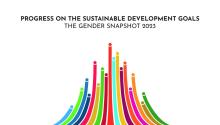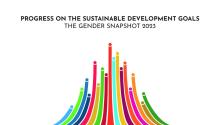Goal 1: No poverty: The report forecasts that by 2030, 8 per cent of the global female population (approximately 342 million women and girls) will continue to live on less than USD 2.15 a day. Only 42 per cent of countries have sex-disaggregated poverty data readily available, impeding targeted interventions.
Goal 2: Zero hunger: While progress in narrowing the gender gap in food insecurity has been made, roughly 24 per cent of women and girls may still experience moderate to severe food insecurity by 2030. Gender disparities in agriculture persist, with limited access to land, resources, and ownership affecting productivity.
Goal 3: Good health and well-being: While maternal mortality reduced globally from 2000 to 2020, progress has stagnated since 2015. High maternal death rates in sub-Saharan Africa and Central/Southern Asia highlight inequalities in healthcare access and quality.
Goal 4: Quality education: Increases in girls’ enrolment in education are commendable, but nearly 110 million girls and young women could remain out of school by 2030 if progress stalls. Gender gaps in education and training opportunities persist, affecting future earning potential and overall development.
Goal 5: Gender equality: Gender equality sees limited progress, with just two of this goal’s indicators nearing their targets. No indicator has fully met its aim.
Deep-seated biases persist, marked by unequal health access, unequal political representation, economic gaps, and inadequate legal defences. Critical data for monitoring progress is missing in many countries. Furthermore, 28 countries do not recognize women’s equal rights in marriage and divorce. Globally, 19 per cent of young women are married before age 18, and there is a notable disparity in leadership roles.
A significant investment of an additional USD 360 billion annually is crucial to achieving gender equality, a cornerstone to meet broader sustainable development objectives.
Goal 6: Clean water and sanitation: While more women now have access to safe drinking water, around 380 million women and girls live amid high or critical water stress, a number projected to increase to 674 million by 2050 due to climate change.
Goal 7: Affordable and clean energy: Approximately 341 million women and girls could lack access to electricity by 2030, with clean cooking fuels remaining out of reach for many. Universal electricity could elevate 185 million women and girls from poverty by 2050, and modern cookstoves could prevent 6.5 million pollution-related deaths.
Goal 8: Decent work and economic growth: Disrupted careers, care responsibilities, and wage discrimination mean women only earn a third of the global income generated by labour. For each dollar men earned in labour income, women earned only 51 cents. The gender wage gap and underrepresentation of women in the labour force continue, indicating the need for policy reforms to ensure equitable opportunities and wages.
Goal 9: Industry, innovation and infrastructure: Women hold 21 per cent of STEM (science, technology, engineering, and mathematics) jobs and only one in three researchers is a woman. Gender disparities in technology and innovation persist, hindering women’s participation in STEM fields and impeding progress in emerging technologies like artificial intelligence.
Goal 10: Reduced inequalities: Gender discrimination comes in many forms and remains commonplace, undermining human rights. According to latest available data, up to 21 per cent of people living with HIV reported being denied health care in the past 12 months, and up to 26 per cent of women living with HIV reported that their treatment for the virus was conditional on taking contraceptives.
Goal 11: Sustainable cities: By 2050, urban areas are expected to house 70 per cent of the world’s female population, totalling 3.3 billion. Alarming trends suggest a third of these women and girls could find themselves living in inadequate housing or slums. Moreover, women with disabilities, representing approximately 18 per cent of the female population, face heightened challenges. A 2022 study indicated that a mere 27 per cent of 190 countries and regions explicitly protected the rights of women with disabilities.
Goals 12–15: Responsible production and consumption, climate action, life below water, life on land: Up to 158 million more women and girls might find themselves in poverty by mid-century due to worsening conditions fuelled by global warming. This represents 16 million more than their male counterparts. An alarming 236 million more women and girls may experience food insecurity, compared to 131 million men and boys. Despite these numbers, only 55 of the world’s national climate action plans include gender-specific adaptation measures, and only 23 recognize the vital role of women as change agents in the fight against climate change.
Goal 16: Peace and strong institutions: Since 2017, the number of women and girls in conflict-ridden areas has surged by 50 per cent, tallying up to 614 million by 2022. In 2023, those in extremely fragile areas were especially vulnerable, facing higher poverty rates and increased food insecurity. Intimate partner violence is 2.4 times higher in extremely fragile contexts compared to non-fragile settings.
Goal 17: Partnerships: A dire need for enhanced financial backing exists in countries where gender equality lags the most. The yearly budget dedicated to gender equality as a principal objective remains low at USD 5.7 billion, just 4 per cent of total bilateral aid. This minimal support, coupled with the fact that only one in four countries actively tracks gender equality funding, underscores the challenges faced in achieving parity.

